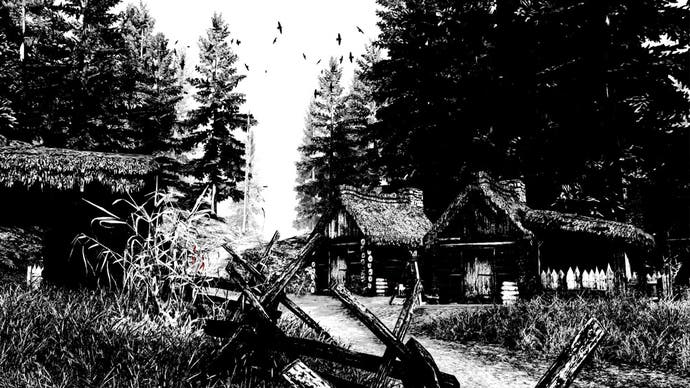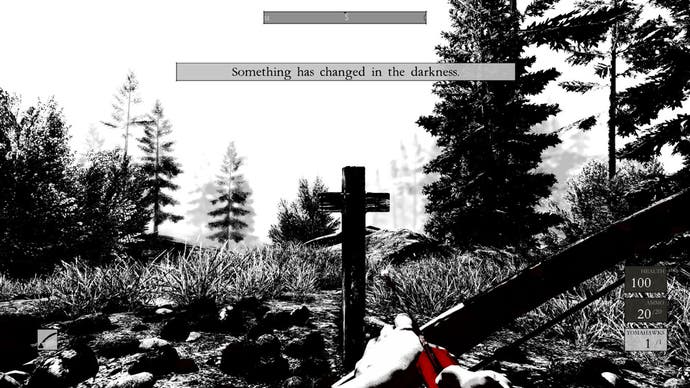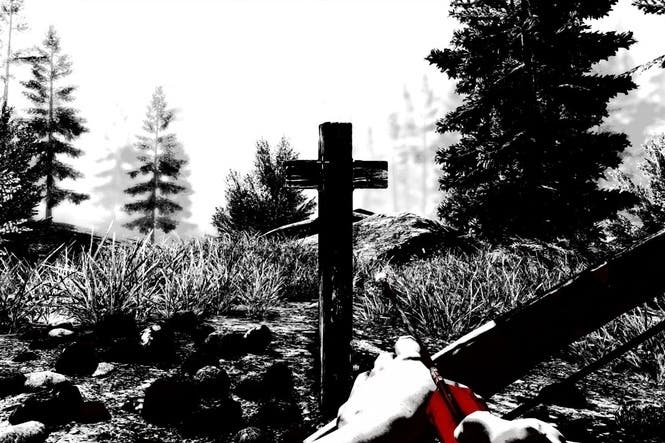Ex-Monolith dev details its upcoming FPS Betrayer
Available today on Steam Early Access.
Perhaps my favourite combat in any first-person shooter would be the tense cat-and-mouse skirmishes of Monolith's 2005 cult classic F.E.A.R. The cunning enemy AI, glorious slow motion and exaggerated particle effects that turned the most banal office into a warzone alongside my favourite video game shotgun ever combined to make this otherwise bog standard action game into a near classic. Now, a six-person studio headed by ex-Monolith devs is creating a new first-person shooter IP in Betrayer, which, for better or worse, sounds nothing like F.E.A.R.
Where F.E.A.R. was all about feeling completely badass (which probably explains why it wasn't scary at all), Betrayer is going to make you feel weak and vulnerable as you navigate its stark black & white rendition of 1604 Virginia. Speaking with Blackpowder Games' creative director Craig Hubbard, I'm told it will be more along the lines of Metro 2033 than Monolith's 2005 love-letter to John Woo.

Much of this is due to the haunted setting, where you must rely on early 17th century weaponry. Hubbard says he was inspired by the action scenes in The Last of the Mohicans. "It's just so fluid and so brutal," he explains. "Just the way they'll fire a shot, then they'll drop the musket and pick up another one. You don't actually drop a musket in the middle of combat [in Betrayer], but you can carry multiple weapons, so you can be flipping between loaded muskets and then switching to your bow and then throwing an axe and meleeing."
I ask if he'd classify it as closer to the Metro series' intentionally cumbersome jerry-rigged weapons than F.E.A.R.'s oh-so-powerful shotgun and soldier-impaling nailgun. "I think it's closer to the Metro series," he replies. "With the mechanics I was talking about, the goal there is to make it feel fluid and intuitive where you're not mad at the controls, where you're probably going to die a lot in this game. It's pretty hard."
You won't be entirely weak though, as, like in Metro 2033 and Far Cry 3, you'll be able to skulk around in the shadows and stealthily take out foes. "I have a weird reaction to stealth. Where if stealth is there, I will always use it. But when it's forced on me, I resent it," Hubbard says. "So we try to strike that balance. If you don't want to play stealthy you don't have to."
Beyond not being a cybernetic cloned super-soldier (or whatever you are in F.E.A.R. and almost every other shooter these days ), you're also going to be at least slightly impaired by Betrayer's intentionally confusing black & white visual style. However, this isn't the case of style over substance, as one might think. Rather the style is the substance.

"We didn't do this as an artistic choice, we did it as a gameplay thing," states Hubbard, who explains that it was inspired by the law of closure, in which the brain fills out an image by looking at the negative space. "Our brains are already wired to make sense out of incomplete visual data, so when we happened upon this, we realised that kind of what was happening was it's just a really different way of seeing an environment and seeing a game world. It adds to the tension that you don't get when the visuals are much more literal. It seemed like it was kind of intense and we were a little bit nervous about it, but we enjoyed playing it so much that we just kept coming back to it."
"You look at something differently than you would have before and that tension that it creates really, really adds to the gameplay experience and I think that's the thing that makes it different," says Blackpowder co-founder Larry Paolicelli. "We didn't just throw a graphical switch and go 'let's do black and white.' It was literally built into the whole premise of the game."
While it may sound like this would get in the way, Hubbard assures me that enemies aren't supposed to be camouflaged, because that would lead to a frustrating experience (not to mention headaches from all the squinting). "We've all played games where you're being shot at by guys you can't see, and we definitely don't have that. That's not the type of game we're making. You can find enemies and finding them is never a problem."
Hubbard notes that the unsettling visuals aren't due to Betrayer being in black & white, but rather a result of setting the contrast to super high. "It doesn't come from it being black and white, it comes from the high contrast, because it crushes everything down until it's almost two-dimensional."
"We actually experimented doing this with a slight colour washover and you actually get the same effect when there's colour there. It's just [that] it starts to look a little too pleasant... Like there's this sort of pretty, almost old postcard quality to it that's really, really attractive, but it lacks the sense of tension that you get when it's a little more stark."
The developer is also proud of Betrayer's environmental storytelling, which it promises will be better than F.E.A.R.'s rampant voicemails. "Honestly, that was a bandage solution," Hubbard admits. "We ran into a lot of problems on F.E.A.R., which is the subject for a whole other discussion, but essentially we were on a new engine, we had a new team, [and] so we were having to make a lot of cuts and that was just one of the things. That was just a patchwork solution to try to make it all make sense. It wasn't originally what we wanted to do."
Instead, Betrayer's story will be told by interacting with several "ghost-like" characters, and observing the setting. "You're reading between the lines. Like if you find a site where something happened you may find several clues there, but from those clues you can start to piece together your own theory about what happened... It's never spelled out."
It's not just the story that won't be handed to you on a silver platter, but the overall game design will be a sort of trial by fire as you're left to explore this harsh climate. "These days it's really common for a game to just walk you through everything and it's sort of like being on a guided tour where the game tells you 'okay, do this now' or 'okay, do this in this order' or 'duck in the grass and be quiet' whereas we don't do that," Hubbard says. "We don't explain a lot of game mechanics. We just tell you what the controls are and then you can kind of experiment and try to figure out how best to deal with different threats."

This won't be an open-world game, though. Not in the traditional sense, anyway. Hubbard likens Betrayer's format to Fable 3, with large hubs and side missions, but each main area opens in a linear progression. He also notes that while you can revisit previous areas, you really don't have to. "It's not like Zelda or Metroid in that way," he clarifies.
While Betrayer will feature a foreboding world, oppressive visuals, and rustic weaponry, Blackpowder doesn't consider it a horror game. "It's eerie, but it's not a horror thing," states Hubbard, who says he'd classify it as more of a ghost story and more along the lines of S.T.A.L.K.E.R.'s tone. "We're not trying to scare. But at the same time it has this very eerie tone and there is this very apocalyptic sense to the world."
He also compares it to Demon's Souls and Dark Souls, whose brilliant death mechanic Blackpowder shamelessly admits to lifting (much as ZombiU did last year, to great effect). "One of the things we've adopted from Dark Souls is when you die you drop whatever money you're carrying. So if you respawn and you want that money back you're going to have to go get it, but now all the enemies are back in the area and you have to be careful or you'll lose the money. And the money is how you buy better weapons and how you grow."
First-person shooters and abandoned-colonies-where-something-terrible-has-happened are probably the two most tired tropes in games these days and Betrayer doesn't sound sound like it's going to reinvent the wheel, but that's not Blackpowder's goal. Instead it aims to mix the spooky vulnerability of Metro 2033 with the anxious death mechanic of Demon's Souls, the large-scale exploration of S.T.A.L.K.E.R., and the bold visuals of... I don't know, a 17th century Madworld, perhaps?
If that's your cup of tea, you won't have to wait long to try Betrayer out. In fact, you won't have to wait at all, as it just became available today on Steam Early Access for £11.99 / $14.99.


